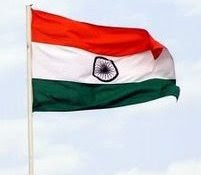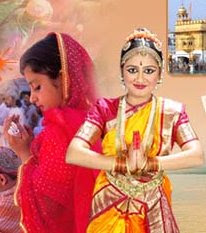 “Red Fort” or “Lal Qila” (Lal means red & Qila means fort) is the largest monument of Old Delhi, India. Red fort is more popularly known is a masterpiece of architecture stands strong on the banks of the River Yamuna as an irregular octagon. Mughal Emperor Shah Jahan started construction of the immense fort in 1638 and work was completed in 1648.
“Red Fort” or “Lal Qila” (Lal means red & Qila means fort) is the largest monument of Old Delhi, India. Red fort is more popularly known is a masterpiece of architecture stands strong on the banks of the River Yamuna as an irregular octagon. Mughal Emperor Shah Jahan started construction of the immense fort in 1638 and work was completed in 1648.Red fort is surrounded a wall of about 2.4 kilometers in boundary and is built of red sandstone. It is hunting spot for artifacts for tourists from both India and abroad. Before the first war of the independence of 1857, the Red fort presented an altogether different picture from what its presents today. Only about 25% portion of the imposing structure is accessible to visitors, the rest of the area being under the control of the Indian army. This part of the fort became an army cantonment after the uprising was suppressed. In 1858, a large number of places in the fort were demolished, many of the taikhanas (basements rooms) sealed, and massive barracks constructed for the soldier.
Information for Tourists :
 Before the first war of the independence of 1857, the fort was a mini-city with palaces, offices, workshops and halls of audience etc. About 3,000 visitors lived there. But, today more than 12,000 visitors come to savour the magnificence of the building everyday. There are 15 distinct structures within the fort, the first being the Lahore Gate and the last one the Moti Masjid. The barbican added by the Mughal Emperor Aurangzeb, veiled the Lahori Gate. On 15th August (Independence Day) & 26th January (Republic day), the Prime Minister enters the Red fort from Lahore gate, unfurls the national flag and addresses the nation.
Before the first war of the independence of 1857, the fort was a mini-city with palaces, offices, workshops and halls of audience etc. About 3,000 visitors lived there. But, today more than 12,000 visitors come to savour the magnificence of the building everyday. There are 15 distinct structures within the fort, the first being the Lahore Gate and the last one the Moti Masjid. The barbican added by the Mughal Emperor Aurangzeb, veiled the Lahori Gate. On 15th August (Independence Day) & 26th January (Republic day), the Prime Minister enters the Red fort from Lahore gate, unfurls the national flag and addresses the nation.The entrance of the gate leads through a long covered bazaar called the chhatta chowk. From Chatta chowk follows the Naggar khana. Naggar Khana is also called “Drum Room” or “Welcome Room”. In the days of Mughal empire, it formed part of a square enclosure with apartments for the urn rah (Nobles) on duty. It was at this point that everyone had to dismount from the elephants and walk towards the magnificent. Visitors can also visit the Diwan-i-Aam, Sheesh Mahal, Moti Masjid etc. & so many interesting places.
Diwan-i-Aam :
Diwan-i-Aam (hall of public audience) from where, the emperor used to listen to the grievances of the common peoples. The emperor did not dismount. Diwan-i-Aam was originally gilded with elaborate stucco work. However, today only the shell of the magnificent structure can be seen. Along the eastern wall of the fort and commanding a scenic view of the Yamuna River, the private realm of the emperor was spaced out.
Sheesh Mahal (Sheesh Means mirror & Mahal means Palace) :
Opposite to the Musamman Burj and just below the Diwan-i-Khaas hall, at the northeastern end of the khaas mahal countryyard is the Sheesh Mahal or the Mirror Palace. It is believed to have been the royal dressing room and its walls are inlaid with tiny mirrors, one of the best specimens of glass-mosaic decoration in India. Mirrors were embedded in the ceiling, which reflected lights in attractive variety. The sheesh Mahal is composed of two large halls of equal size. Both are connected in the centre by a broad arched opening on the sides by two narrow passages.
Moti Masjid (Pearl mosque) :
Besides the conclaves, the emperors would also rest in privacy pondering over various issues. Moti Masjid (pearl mosque) was a private masjid and was added by the emperor Aurangzeb. In the Masjid, there are three domes in perfect proportion, gives it a rare look of elegance. To the north of this masjid is the Hayat Baksh, a Mughal garden built by Shahjahan. At the southern and northern ends are the Sawan Bhadon pavilions, in the centre of the garden is the grand Zafar Mahal.
History of Red Fort :

In the Mughal Dynasty, Shah Jahan was one of the greatest rulers in India. Shah Jahan was well known in India for his leadership as well as for his great architectural accomplishments. During his reign, he moved the capital of India from Agra to Delhi, where the construction of a new city would take place. Here, a new and great palace for Shah Jahan was built, the Red Fort. Its name came from the huge red walls that surrounded it, some of which that were as high as 100 feet. These walls enclosed the finest, most beautiful of all Mughal palaces. It is made of and decorated in marble, gold and precious stones, inlaid into intricate mosaics.
The Red fort served a great purpose for nearly 200 years as the centre of Mughal Empire. The Emperors led their lives with great pomp and ceremony. From here, they could show themselves to his public in a ceremony called darshan from a large balcony. They received public petition and massages in the Diwan-i-Aam, discussed important state matter with his principle state ministers in the Diwan-i-Khaas, discussed the most trusted officers in the Royal Tower or Shah Burj, held lively gathering and feats and retired for the night. This place was the greatest of Mughal Palaces and was the heart of Shah Jahan’s empire.
Photo Gallery

The Red Fort - Delhi

Lal Quila - Delhi

Red fort with Indian Flag

Red Fort - Famous Monumnet of India

Visitors at Red fort












1 comment:
Invite you all!
We have a number of Mp3 playlist collected on our website.
Please come and listen to songs at: Free Online Mp3 Songs
Thanks!!
Post a Comment